ARAS Connections: Image and Archetype - 2017 Issue 1

"Whoever speaks in primordial images speaks with a thousand voices; he enthralls and overpowers...he transmutes our personal destiny into the destiny of mankind, and evokes in us all those beneficent forces that ever and anon have enabled humanity to find refuge from every peril and to outlive the longest night.”
― C.G. Jung, The Red Book: Liber Novus
ARAS Connections is not the BBC, CNN, MSNBC, Fox News or Breitbart. It is a quarterly online journal that “speaks in primordial images" as they appear in the contemporary psyche and culture as well as in the art and myths of earlier cultures from around the world. When the state of the world and its politics fall into crisis as is our current reality, symbolic imagery from the creative psyche spontaneously emerges from the depths to orient us by providing deep feeling and guiding narratives from our own and other cultures. It is at the interface of symbolic imagery and political upheaval that this edition of ARAS Connections focuses.
John Perry, a Jungian analyst of an earlier generation, defined an archetype as “an affect/image”. This edition of ARAS Connections is full of “affect/images” in which our current political realities and our psyches are being emotionally, intellectually and spiritually assaulted with revolutionary reversals in the United States and Western Europe and with human tragedies of unimaginable proportions in countries such as Syria and Iraq. We hope that these images and words will evoke in you "those beneficent forces that ever and anon have enabled humanity to find refuge from every peril and to outlive the longest night.”
In our last, special Presidential Election edition of ARAS Connections we published seven image rich articles from the pre election San Francisco Jung Institute Presidential Conference. In this edition, we have added three more articles from our distinguished colleagues in Santa Fe, New Mexico who, just a mere two weeks after the November 8, 2016 election, provided their shell shocked audience with a set of preliminary reflections and images in a post Trump election debriefing. Jacqueline West, Donald Kalsched, and Jerome Bernstein are among our most thoughtful and creative analysts and each provides a perspective that helps us “see” just a bit more clearly what is happening in our world.
Growing out of a new Jungian activism in the world, Australian analyst Amanda Dowd offers in Adrift a heart rending psychological perspective on the art that is emerging out of the Syrian refugee crisis. This contemporary commentary is a continuation of Amanda’s ongoing meditation on memory, history, and on the links between self, place, and identity that results from the profoundly dislocating experience of migration and displacement. As co-editor of the book Placing Psyche: Exploring Cultural Complexes in Australia she also explored this theme in another context, namely that of her own experience and that of a large part of the Australian population in her brilliant chapter, “Finding the Fish”.
Finally, Jean Shinoda Bolen, offers a commentary on images from the January 21, 2017 world wide Women’s Marches that drew over 5 million people on the day after Donald Trump’s inauguration. Jean has been in the forefront of Jungian political activism for many years and describes this marriage of inner and outer in the following way: "Activism and individuation (to find a meaningful, inner directed, chosen life-path) come together when the choices we make express who we are and who we are becoming."
As I wrote at the outset, ARAS is not a news organization and it is not a political organization. Having said this, the editors would consider for publication papers using word and symbolic image to present alternative views on the Trump election, the Syrian refugee crisis and/or the world wide Women's Marches. Symbolic and archetypal imagery does not belong to any single political party or political perspective.
The State of our Country: Where Have We Been and Where Might We Be Going
The following three papers were presented by the C.G. Jung Institute of Santa Fe on November 18, 2016, just ten days after the United States Presidential Election.
The State of Our Country

Any number of us here are wrestling, intensely, with upheavals in our personal and collective psyches, the rumblings and eruptions over the past many months, the startling, even shocking results of the election last week . . . and the subsequent vivid and distressing clues about how the structures of our country will be re-interpreted by the appointments of our President-elect and how his policies will transform our lives, explicitly and implicitly. My immediate reaction to the results of the election was, to express it in an acronym, WTF!! . . . which carries a good dose of anger, paired with a half-question, and which carries an invitation to reflect. Both the energy of outrage and curiosity of mind are essential to using our voices. I think the most crucial position we can each take at this point is for each of us to find ways of using our voice – in words and in action.
Over the past few years I’ve been writing – and talking-- about how I see our nation as being in the grip of what I call “Alpha Narcissistic dynamics”. During the past year, the heat of these dynamics rapidly increased. They have found their embodiment spectacularly in Trump. I want to offer some reflections about these dynamics that I hope may strengthen each of our individual and collective backbones in this time of intense stress.
Click here to read The State of Our Country in its entirety.
Reflections on Hate in the Recent Election and in the American Psyche: How Do We Become Emotionally Literate
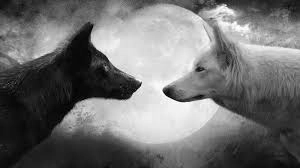
The best lack all conviction,
And the worst are full of passionate intensity.
W.B. Yeats; The Second Coming
Introduction
Many commentators on our current political scene have noted how much anger and hate there is in the country right now and how our President-elect Donald Trump has been a lightning rod for this anger, exploiting it to his own political advantage, all the while fanning the flames of hatred with his inflammatory rhetoric, his outright lies, and his denigrating Twitter-messages. Now, after the election, the country is still saturated with intense, polarized and polarizing emotion that seems increasingly to have taken over the national dialogue and pushed it toward extremism.
Last summer, I found myself pulled into this maelstrom, and spent much of my vacation time in Canada reading the New York Times and trying not to hate Donald Trump. My own hatred became a problem for me, and this is one of the reasons I decided to explore the issue of hatred in the American election and in the American psyche. Here are a few of the questions I want to touch on from a psychological perspective. What constellates hate in an individual personality and in a nation? How can hate be contained and transformed into usable anger in the service of the good? How, in other words do we promote “emotional literacy” in ourselves and in our community as a nation? And how do we do so when so many spokespersons in the nation are exploiting us emotionally—goading us towards outrage and hatred in order to distract us from the “inconvenient truths” and painful realities of what it means to live with an informed heart in the complicated, inter-dependent world of the 21st century.
Trump Isn’t Fun and Neither Is Paradigm Shift: Where Are We Headed?!
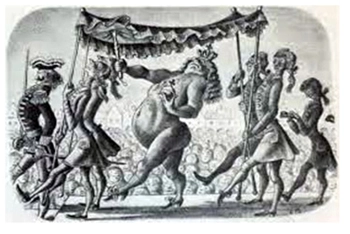
When I tried to sit down and write out my thoughts for this, I encountered enormous resistance. So I stopped and sat with myself and focused on what I was feeling in my body. What I heard was a voice that said, “I’m pissed off and I don’t want to organize or make sense of this madness.” And after a few more minutes I realized that what I was experiencing was the chaos that has erupted in our country and in the American psyche. This election season has left us in a state of chaos with, in my view, much more to come. So, the rest of my comments will reflect what’s roiling in me and some of what I see roiling in that chaos.
I would say that on November 8th, Election Day, the entire country and much of the world got a crash course in what the trickster archetype looks like and how it operates. There is a Navajo legend about how First Woman was organizing the stars and the constellations, carefully laying them out in patterned linear fashion on a huge Navajo blanket to be placed in the cosmos. Coyote happened to be wandering by, looked over and saw the stars laid out neatly on the blanket. “Hmmm,” he said and then he picked up a corner of the blanket, lifted it up and flicked it down, flinging the stars in disarray into the heavens. According to Navajo legend, that is how we have come by the various constellations that we see in the cosmos.
I had a similar feeling as I sat and watched TV on November 8th, confidently knowing that for all his extraordinary powers to hold a substantial segment of the American population in his sway, Donald Trump would lose the election. And besides, all the pollsters said so, as well as all the pundits. There we were, all smug and confident for a few hours and then suddenly, over the course of just a couple of more hours, we saw coyote pick up the corner of that beautifully woven tapestry and flick order into chaos.
Click here to read Post-Election Panel in its entirety.
ADRIFT
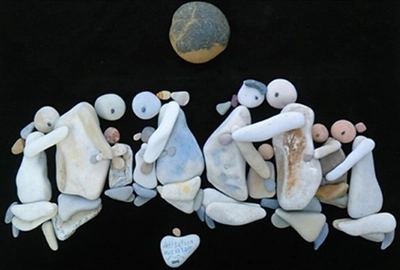
‘Art does not reproduce what we see, rather it makes us see’, Paul Klee.
The images which you will find here are creative responses by Syrian refugees and artists to the almost unimaginable plight of the many thousands of refugees displaced by the Syrian war. They are gestures made into the empty spaces of destroyed homes, communities and cities, temporary refugee camps and makeshift roadside dwellings, overcrowded buses and boats adrift on endless roads and inhospitable seas. They speak of the empty eyes of mothers and fathers who have lost loved children, wives and husbands and, for the time being, any sense of safety, purpose and future.
These images are a testament to both the inhumanity of war and the courage of the human spirit and all give voice to an experience and grief which is beyond words. Figures 2, 3, 4 and 11, 13 and 14 are examples of the work made by refugees who have found some sanctuary in the various camps in the Middle East (the names of the artists have been withheld by the UNHCR).
Before we can find words, it helps to find an image--or to make one--that can hold the experience for us until it becomes safe enough to feel the emotions associated with it. Only when we are safe enough to feel, are wel able to think about what has happened and find a place for it in mind and memory. In the finding and creating of images an oppurtunity arises that can potentially transform an empty inhumane space into an imaginative human place in which feeling and hope of recovery might be found again, even if momentarily. Relief in such circumstances may be fleeting but a thread, however flimsy, can help humans continue to put one foot in front of the other.
The Women's March on Washington: Pink Pussyhats - Enantiodromia
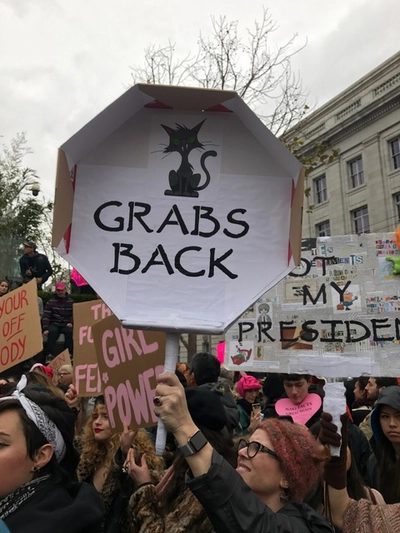
The idea of a Women’s March on Washington on January 21, 2017, the day after Donald Trump’s Inauguration, ignited the largest protest in American history, one that spread to 673 cities in 92 countries; an estimated 5,600,000 marchers in all. The idea traveled faster than wildfire through the internet. The symbol of the marches—a sea of them, seen all over the world was the hand-knitted pink pussyhat. It began with a Facebook page begun by Teresa Shook, a retired attorney and grandmother in Hawaii who posted the idea of the Women’s March on Washington on November 8, after the election results were in. The next morning, there were 10,000 responses, and from there--the rest is history.
I came back from Washington, D.C. profoundly affected by being there with over a half a million others: grandmothers, mothers, grand-daughters and grandsons; young parents with young children, fathers carrying babies, high school and college friends, gray and white haired older women, a diversity of ages and races—though predominately women and lots and lots of hand-lettered signs. There were no confrontations with police, kindness and consideration were the norms. It was, to quote a man I overheard, “the nicest mob scene I’ve ever been in.” There was hardly room to move, and no room to march, with so many of us packed into the mall.
Most of the women I knew who had planned to march in Washington, DC, in San Francisco and in other cities close to home, were participating in their very first march. Like me, they had felt called to the March – with some stress and anxiety at not knowing how it would turn out and online advice on what to do if it turned into a riot. The reality was anything but this. There was togetherness and human warmth, humor and kindness. After reflecting and contrasting this with other demonstrations, I think that this can be attributed to women’s oxytocin-estrogen response to stress that is in contrast to male-led adrenaline-testosterone protests that often invite retaliation by police. Researchers at UCLA called this the “Tend and Befriend” response to stress, which is characteristically what women do. Hillary Clinton’s unexpected loss to Donald Trump and the anxieties about what would happen next was a major source of stress. Through tending and talking, women reduce the stress and as they do so, oxytocin (the maternal bonding hormone which is enhanced by estrogen) increases. We were in a sea of pink pussyhats and oxytocin.
Click here to read The Women's March on Washington: Pink Pussyhats - Enantiodromia in its entirety.
Click here for more images from the Women's Marches.
We welcome additional contributions as we are creating an archive of images from that most unique day. Images can be sent to info@aras.org. Thank you!
The Poetry Portal
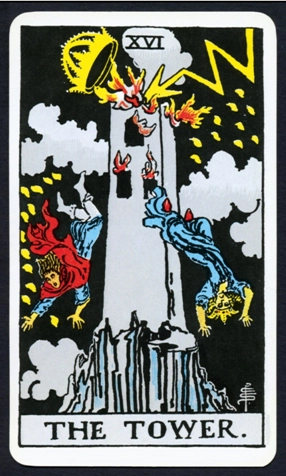
With this issue we are happy to introduce Miriam Atkin as guest editor for The Poetry Portal. Some of you have met her already as the curator of one of our Ekphrastic poetry events at ARAS in New York. We also want to thank Ellen Liberatori who began The Poetry Portal and the many poets who have contributed poems inspired by an image from the Archive, most recently Van Gogh's painting "Starry Night". Welcome Miriam!
-Ami Ronnberg
This spring issue of ARAS Connections inaugurates a new format for the Poetry Portal. Whereas we solicited multiple submissions in the past, we have decided to hone our focus and invite one writer per season who will compose poetry that reflects upon an archetypal image chosen from the archive. The quarterly Poetry Portal publications will correspond with events in our ongoing Ekphrazein Reading Series, which presents ekphrastic writing about ARAS images to the public.
-Miriam Atkin
THE BLUE BUTTERFLY I FREQUENTLY SEND
by Venn Daniel
By scenery the room grew
larger than I expected.
This morning's body
disintegrating
in what I thought was a wing
but ended up being an accumulation.
Plumes of smoke
too many cups of coffee
and a terrifying attempt
to bring myself to terms
with a variety of my own thoughts.
How the day
eventually comes
into view and I failing, to hold
throes of passion and despair
in sight long enough
for things to change shape
and how it's not just words
I'm at war with.
The chilling visions of a few
unfortunate men
for as long as I can remember
have kept my sex forced
into an impasse high
with blinding sun
and framed
by the guise of a wall.
Most of my love rests
in faces outside
where I only feel able
in glimpses or short bursts
of animated emotion
to come out
and protrude. I from the scene
of potentials and structures
glint in coagulation.
3.8.17
Venn Daniel is a poet. His work has been published in The Poetry Project Newsletter, This Image Journal, and elsewhere. Venn also makes collage and has most recently published two pieces in collaboration with Sara Jane Stoner, for her book Experience in the Medium of Destruction (Portable Press @ Yo Yo Labs). He is very grateful for his friends and his friends who have been mentors. He invites you to email him at venndaniel@icloud.com or view the photographs he posts on his Instagram @venn.daniel. He lives in Brooklyn.
Contents
- The State of our Country: Where Have We Been and Where Might We Be Going
- The State of Our Country
- Reflections on Hate in the Recent Election and in the American Psyche: How Do We Become Emotionally Literate
- Trump Isn’t Fun and Neither Is Paradigm Shift: Where Are We Headed?!
- ADRIFT
- The Women's March on Washington: Pink Pussyhats - Enantiodromia
- The Poetry Portal
Become a Member of ARAS!
Become a member of ARAS Online and you'll receive free, unlimited use of the entire archive of 17,000 images and 20,000 pages of commentary any time you wish—at home, in your office, or wherever you take your computer.
The entire contents of three magnificent ARAS books: An Encyclopedia of Archetypal Symbolism, The Body and The Book of Symbols are included in the archive. These books cost $330 when purchased on their own.
You can join ARAS Online instantly and search the archive immediately. If you have questions, please call (212) 697-3480 or email info@aras.org
We Value Your Ideas
As our newsletter grows to cover both the ARAS archive and the broad world of art and psyche, we're eager to have your suggestions and thoughts on how to improve it. Please send your comments to info@aras.org. We look forward to your input and will reply to every message.
Subscribe
If you're not already a subscriber and would like to receive subsequent issues of this newsletter by email at no cost, e-mail us at newsletter@aras.org.
